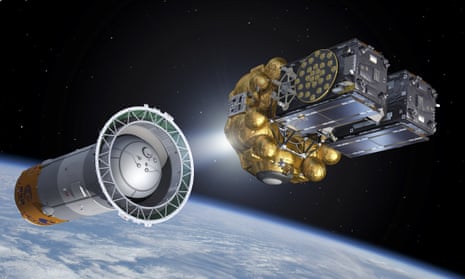It’s a total fluke. No one was thinking about making the most precise test yet of general relativity when the Soyuz rocket lifted off from French Guiana on 22 August 2014. The European Space Agency was launching Galileo 5 and 6, a pair of navigation satellites to break Europe’s reliance on the American GPS system.
At first everything appeared to be going well. The rocket cleared the launch pad and sped away from the surrounding rain forest on its way to space. But trouble was brewing inside the rocket’s upper stage, the final motor that would put the satellites into their operational orbit.
A pipe containing frigid liquid helium had been placed too close to a fuel line. The fuel froze, stopping the upper stage from manoeuvring correctly and placing the brace of satellites in the wrong orbit.
Instead of a circular path, they followed elliptical orbits from 13,713 km up to 25,900 km and back down again. Using onboard thrusters, the satellites were manoeuvred into somewhat less elliptical orbits and a team of specialists is now studying whether this will allow them to be used for their intended navigation purposes. Even if not, the satellites are far from a complete write-off.
They continue to orbit Earth twice every day, changing their altitude by 8500 km on each circulation. As luck would have it, this makes them perfect for a world leading test of Einstein’s general theory of relativity.
Devised 100 years ago this month, general relativity is a theory of gravity. One of its mind-bending predictions is that time will pass more slowly in a gravitational field. In other words, clocks on Earth ‘tick’ more slowly than clocks in space.
This was demonstrated on 18 June 1976 by the American space probe Gravity Probe-A, which was lobbed to an altitude of 10,000 km before it fell back to Earth. Although in space for just under two hours, its transmissions showed that the highly accurate clock on board had sped up.
Now, such clocks are routinely used on global navigation satellites because their signals have to be corrected for these effects. They speed up by a few tenths of a microsecond every day. If not taken into account, this would cause navigation errors of around 10 km per day.
The remaining elliptical orbits of Galileo 5 and 6 mean that their onboard clocks will continuously sweep through weakening and strengthening parts of Earth’s gravitational field as they orbit to and fro. This will continuously affect the rates of the clocks in a way that can be predicted by theory and measured from the satellites’ signals.
At the end of the year-long experiment, scientists from the ZARM Center of Applied Space Technology and Microgravity, Germany, and SYRTE Systèmes de Référence Temps-Espace, France, expect to have measured this time dilation to four times the accuracy of previous experiments.
Continually testing Einstein’s predictions is the key to making progress in gravitational physics. There is reason to believe that gravity behaves subtly differently in extremely strong gravitational fields such as those found close to black holes. If so, minuscule variations from relativity’s predictions could be seen in the wider universe. So, physicists are always on the look out for a new way to test Einstein’s ideas.
Scientists often talk about serendipity when accidentally discovering new phenomena that they were not actually looking for. This story shows that the same can happen with spacecraft operations.
And in the centenary year of the general relativity’s formulation, think of it as an anniversary present.
Stuart Clark is the author of The Unknown Universe (Head of Zeus), and co-host of the podcast The Stuniverse (Bingo Productions). He is teaching the Guardian Masterclass, How the Universe Works in December.

Comments (…)
Sign in or create your Guardian account to join the discussion